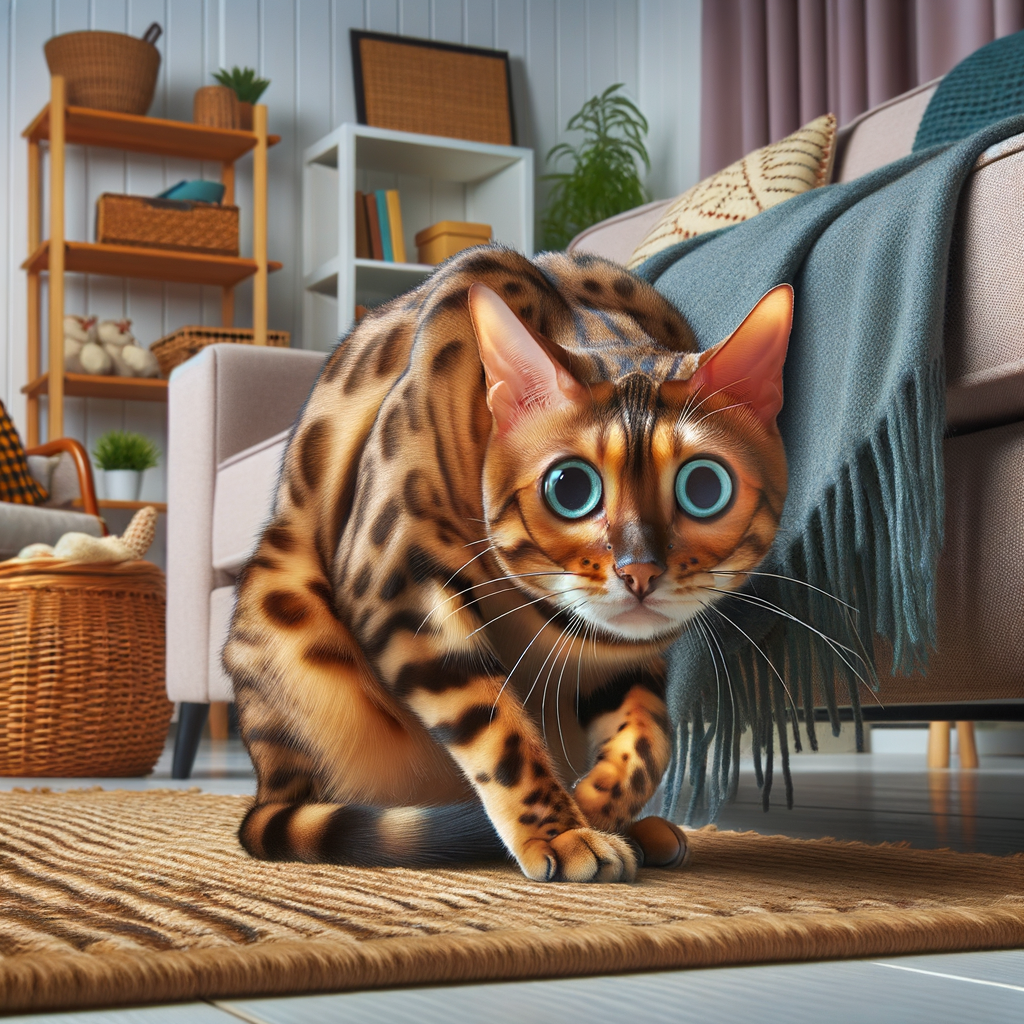
Introduction: Recognizing Anxiety in Bengal Cats
Bengal cats are known for their playful and energetic nature. However, like humans, they can also experience anxiety. Understanding how to recognize anxiety in your Bengal cat is crucial for their well-being.
-
Understanding Bengal Cat Behavior:
They love to explore and play. When their behavior changes, it might be a sign of anxiety. For example, if your Bengal cat starts hiding more often or becomes unusually aggressive, it could be anxious.
-
Importance of Mental Health in Cats:
Just like humans, cats need good mental health. Anxiety can affect their overall health and happiness.
Bengal Cat Anxiety Symptoms
Physical Signs of Stress in Bengal Cats
-
Changes in Eating Habits:
Bengal cats may eat less or more when stressed. If your cat suddenly stops eating or overeats, it could be a sign of anxiety. For example, a normally active Bengal might start avoiding food, leading to weight loss.
-
Excessive Grooming:
Cats groom to stay clean, but too much grooming can be a stress sign. If your Bengal cat is grooming so much that it creates bald spots, it may be anxious. This behavior is often a way for cats to comfort themselves.
-
Unusual Aggression or Fear:
They might hiss, scratch, or hide more than usual. For instance, a friendly Bengal might start avoiding people or other pets, showing signs of fear or aggression.
Behavioral Issues Indicating Anxiety
-
Increased Isolation:
Bengal cats are usually social and playful. If your Bengal starts hiding more often or avoids interaction, it could be a sign of anxiety. For example, they might spend more time under the bed or in a closet.
-
Excessive Vocalization:
Cats communicate through meowing, but excessive vocalization can indicate stress. If your Bengal cat is meowing more than usual, especially at night, it might be feeling anxious. This behavior can disturb your household and is a clear sign to look out for.
-
Unusual Destructive Behavior:
An anxious Bengal cat might start scratching furniture or knocking things over. This behavior is not just a nuisance but a cry for help. Providing more toys or scratching posts can sometimes alleviate this issue.
Identifying Anxiety Indicators in Bengal Cats
Changes in Daily Routine
- Changes in Sleep PatternsIf you notice your cat sleeping more or less than usual, it might be a sign of anxiety. For example, a normally active Bengal cat that suddenly sleeps all day could be stressed.
- Changes in Play HabitsBengal cats are known for their playful nature. If your cat shows less interest in toys or stops playing altogether, it could indicate anxiety. On the other hand, excessive play or hyperactivity might also be a sign of stress.
Changes in Interaction with Humans and Other Pets
-
Increased Aggression or Fear:
One sign of anxiety in Bengal cats is a change in their behavior towards humans and other pets. They may show more aggression or fear. For example, a Bengal cat that used to be friendly might start hissing or swatting. This change can be due to stress or feeling threatened.
-
Decreased Interest in Interaction:
A Bengal cat that once enjoyed playing or cuddling might start avoiding people and other pets. This withdrawal can be a sign that your cat is feeling anxious or overwhelmed.
| Behavior Change | Possible Cause |
|---|---|
| Increased Aggression | Stress or feeling threatened |
| Increased Fear | New environment or changes at home |
| Decreased Interaction | Anxiety or feeling overwhelmed |
Understanding these changes can help you identify if your Bengal cat is experiencing anxiety. If you notice these signs, consider consulting a vet for advice on how to help your pet feel more comfortable.
Bengal Cat Mental Health: Case Studies
-
Case Study 1: Fluffy’s Fear of Strangers
Fluffy is a 3-year-old Bengal cat who lives with her owner in a quiet neighborhood. Fluffy has always been a bit shy, but her fear of strangers became more noticeable when guests visited the house. She would hide under the bed and refuse to come out until the strangers left.
Fluffy’s owner decided to seek help from a veterinarian. The vet suggested a few strategies to help Fluffy feel more comfortable around new people. These included:
- Introducing Fluffy to new people slowly and in a controlled environment.
- Using treats to create positive associations with strangers.
- Providing a safe space for Fluffy to retreat to if she felt overwhelmed.
Over time, Fluffy’s fear of strangers decreased. She began to come out from under the bed more quickly and even started to interact with guests.
-
Case Study 2: Whiskers’ Aggression Towards Other Cats
Whiskers is a 5-year-old Bengal cat who lives in a multi-cat household. Whiskers started showing aggression towards the other cats, especially during feeding times. This behavior caused a lot of stress for both Whiskers and the other cats.
Whiskers’ owner consulted with an animal behaviorist. The behaviorist recommended the following steps:
- Feeding Whiskers in a separate room to reduce competition and stress.
- Providing multiple litter boxes and sleeping areas to prevent territorial disputes.
- Using pheromone diffusers to create a calming environment.
After implementing these changes, Whiskers’ aggression towards the other cats decreased significantly. The household became more peaceful, and Whiskers’ overall behavior improved.
Stress Signs in Bengal Cats: Key Takeaways
- Importance of Recognizing Stress Signs Early:Early detection can prevent more serious health issues. It helps in addressing the root cause before it escalates. Look for changes in behavior, appetite, and grooming habits.
- Impact of Stress on Bengal Cat’s Health and Behavior:Stress can significantly affect your Bengal cat’s health and behavior. It can lead to physical problems like weight loss, hair loss, and digestive issues. Behaviorally, a stressed cat may become aggressive, withdrawn, or excessively vocal.
Bengal Cat Anxiety Treatment
Professional Help for Bengal Cat Anxiety
- When to Consult a VetIf your Bengal cat shows signs of anxiety, it might be time to visit the vet. Look for symptoms like excessive grooming, hiding, or aggression. A vet can help rule out medical issues that might cause anxiety.
- Therapies and MedicationsThere are several therapies and medications available for treating anxiety in Bengal cats. Your vet may recommend behavioral therapy, which helps your cat learn to cope with stress. In some cases, medication can be prescribed to reduce anxiety levels.
Home Remedies for Bengal Cat Anxiety
-
Creating a Safe Environment
Bengal cats need a safe and calm space to feel secure. Here are some tips to create a safe environment for your Bengal cat:
- Quiet Space: Set up a quiet area in your home where your cat can retreat. This can be a cozy corner with a soft bed.
- Consistent Routine: Cats thrive on routine. Try to feed and play with your Bengal cat at the same times each day.
- Safe Hiding Spots: Provide hiding spots like cat trees or boxes. This helps them feel safe when they are stressed.
According to a study by the ASPCA, a consistent and safe environment can significantly reduce anxiety in cats.
-
Interactive Toys and Activities
Interactive toys and activities can help reduce anxiety in Bengal cats by keeping them engaged and active. Here are some ideas:
- Puzzle Toys: These toys can stimulate your cat’s mind and keep them busy. Look for toys that dispense treats as they play.
- Feather Wands: Feather wands are great for interactive play. They mimic the movement of prey, which can be very engaging for your cat.
- Laser Pointers: Laser pointers can provide a fun and energetic way for your cat to exercise. Just be sure to never shine the laser directly into their eyes.
Engaging your Bengal cat in regular play sessions can help alleviate anxiety and improve their overall well-being.
| Remedy | Benefit |
|---|---|
| Creating a Safe Environment | Reduces stress by providing a secure space |
| Interactive Toys and Activities | Keeps the cat engaged and reduces anxiety |
Bengal Cat Anxiety Management: Practical Tips
Managing anxiety in Bengal cats can be challenging, but with the right approach, you can help your feline friend feel more secure and happy. Here are some practical tips to manage your Bengal cat’s anxiety:
- Consistent Routines
Try to feed, play, and interact with your Bengal cat at the same times each day. This consistency helps them feel safe and reduces anxiety. For example, if you feed your cat at 8 AM every morning, stick to that schedule as closely as possible.
- Proper Socialization
Introduce them to new people, pets, and environments gradually. This helps them become more adaptable and less anxious. Start with short, positive experiences and gradually increase the duration and complexity of social interactions.
- Healthy Diet and Exercise
Ensure your Bengal cat eats a balanced diet rich in nutrients. Regular playtime with toys or interactive games can also help burn off excess energy and reduce stress. Aim for at least 15-20 minutes of active play each day.
| Tip | Details |
|---|---|
| Consistent Routines | Feed, play, and interact at the same times daily to create a sense of security. |
| Proper Socialization | Gradually introduce new people, pets, and environments to build adaptability. |
| Healthy Diet and Exercise | Provide a balanced diet and ensure regular playtime to reduce stress. |
Ensuring Your Bengal Cat’s Mental Well-being
Taking care of your Bengal cat’s mental health is just as important as looking after their physical health. By understanding their needs and behaviors, you can create a happy and stress-free environment for your feline friend.
-
Importance of Regular Check-ups:
These check-ups help catch any health issues early, which can prevent stress and anxiety in your Bengal cat. Your vet can also provide advice on how to manage your cat’s mental health.
-
Building a Strong Bond with Your Bengal Cat:
Spend quality time with your Bengal cat. Play with them, talk to them, and show them affection. This helps build a strong bond and makes them feel secure and loved.






